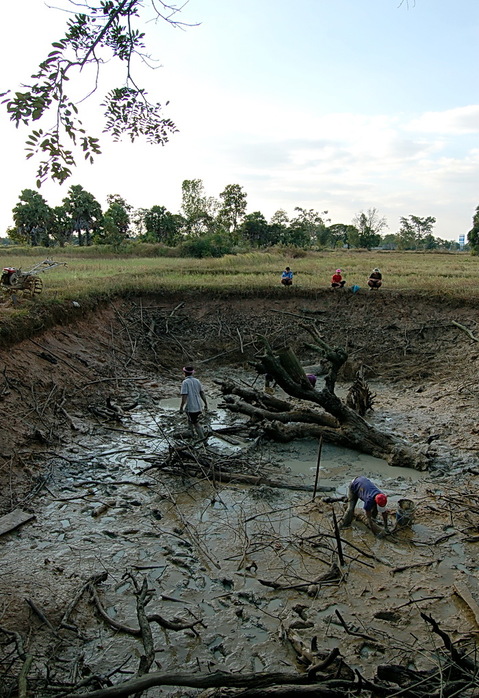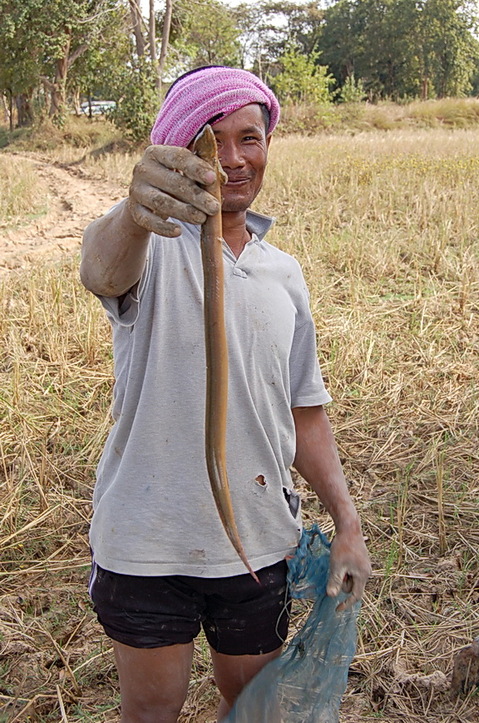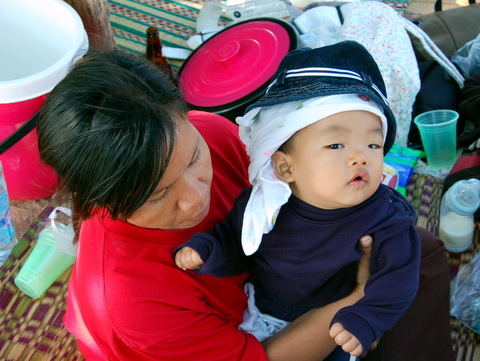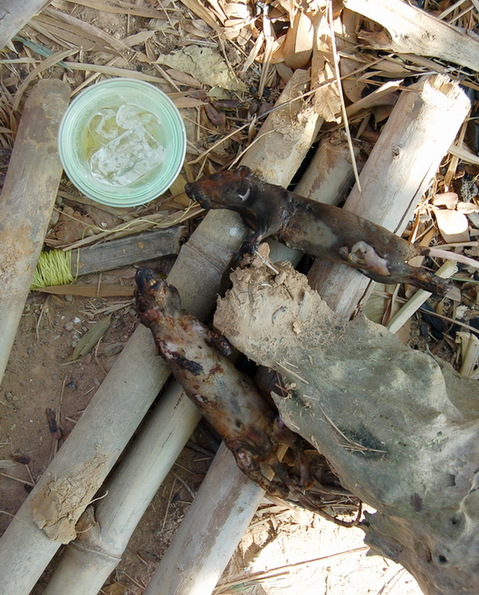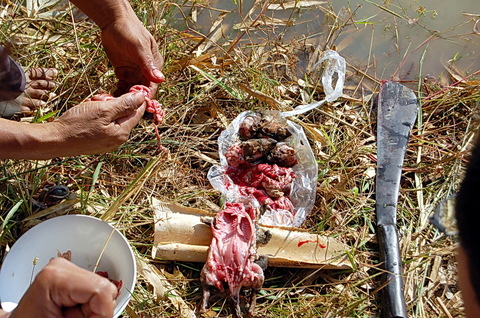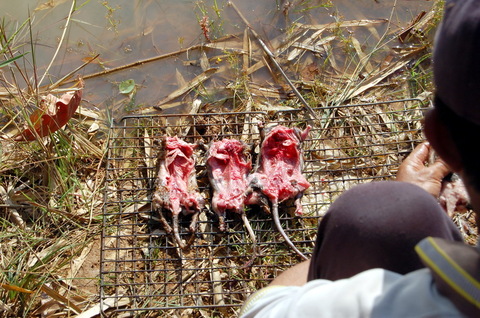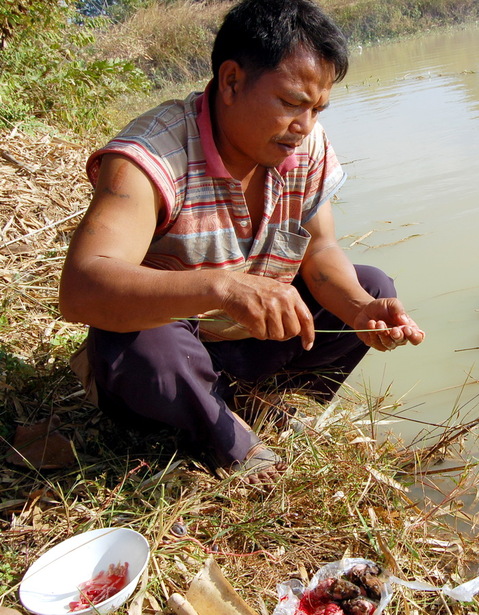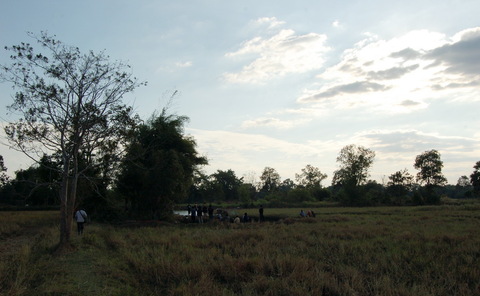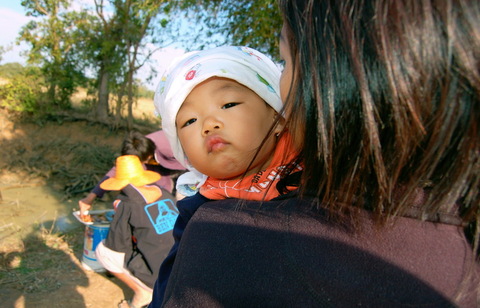Our nanny’s husband has been bringing over various culinary delights (of mostly the jungle food variety) recently since he knows I get a kick out of it and so far, have not refused to try anything. In fact, he’s brought over so much that I’ve not had the time to blog about all of it yet (the photos are ready though, so everything will be covered eventually). A few days ago, he brought over a real treat.
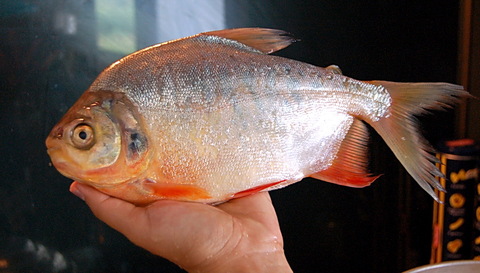
I knew what it was right away because I’ve seen so many nature programs about Amazonian fish: That’s a small pacu. Some googling showed that it’s probably called a red-bellied pacu. The huge pacu you see on fishing shows are usually black pacu. Pacu of any kind are not native to Thailand but seem to thrive here in the tropical conditions, and since pacu can eat basically anything with their gnarly goatlike teeth, food isn’t a problem either. I’m not totally sure if Yao (the nanny’s husband) caught this in a river or a fishing park, but it could be either.
The photo above was taken right before Mr. Pacu got placed in the steam pot. We steam a lot of the fish we eat these days with little or no seasoning so Max can eat with us. Many fish in Thailand taste just fine this way, as log as you season or use a dip afterward. Pacu, however, turns out to be quite devoid of any real taste – the texture is nice and firm, but the flavor is lacking (which is not the case with, say, tilapia or striped goby, or even most river catfish around here). Pacu would be a good candidate for garlic/butter/white wine pan frying I suspect, where a bland fish can really shine.
Sure is a pretty fish, though.
Category: Thai Society/Culture
Bovine 911
Last night, Nam, Max, and I saw something I’ve been expecting to see ever since I came to Thailand.
We had finished dinner at a restaurant just down the road and were on our way home in the Cefiro when we came upon flashing lights at a big curve. A police pickup blocked the view from the rear, but when we passed by we got a clear view of the latest road casualty: A young white cow of the type that used to frequent our yards, locally (and also commonly) known as Brahmans.
When I first started driving around here I was sure this type of accident would be commonplace, but as it turns out, people seem to make sure their animals are in at night. Sometimes cows or small herds of them get away from their keepers during the day when they are set out to graze, but I’ve never seen them on the roads after dark.
This all leads to the question of liability… It seemed that the only party injured last night was the cow, but that could very easily not have been the case… Which party is legally at fault in Thailand? I only know of one related case, personally: A coworker was driving down a country highway and hit a fighting cock trying to run across. The owner ran out from his house and demanded 3000 Baht ($90 US) in compensation. My coworker refused to pay and drove on, and insists this was both legal and the right thing to do.
I’m going to have to ask more people about this.
Thai Jungle Barbecue
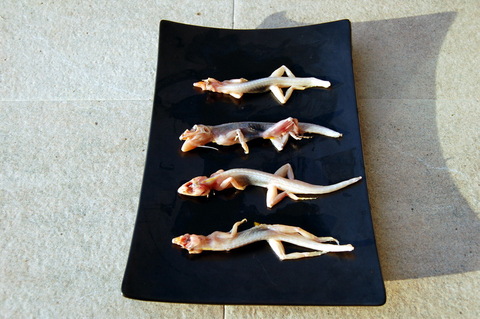
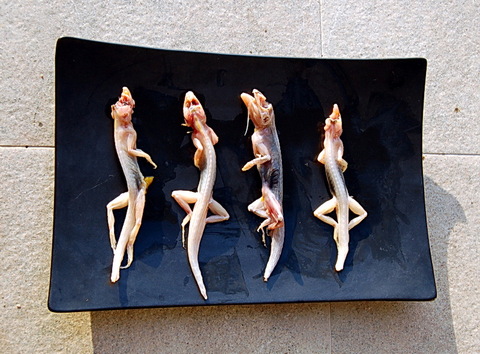
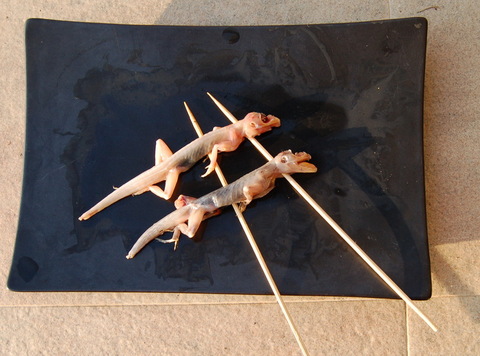

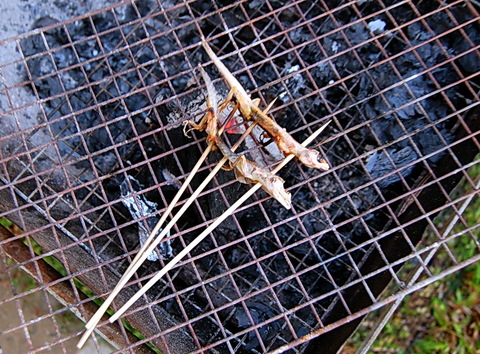
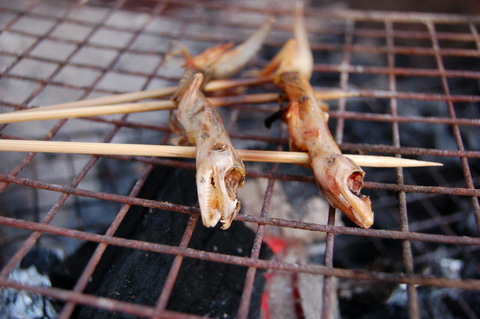
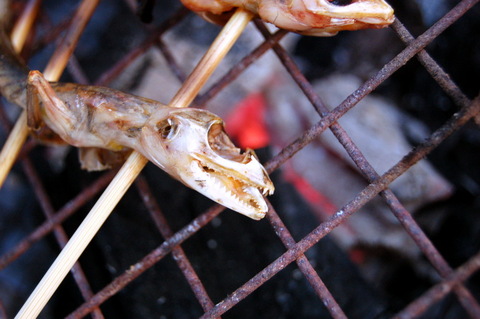
Thai chameleons are surprisingly tasty.
Further explanation will follow in another post…
returning eastward
There’s an article up at the NY Times about how the global economic crisis is affecting the area where we’re living: In Southeast Asia, Unemployed Abandon Cities for Their Villages
(click here for a login if you need one)
Someone turned the heat up…
…it was probably that big, feral, omniscient monkey in the sky.
In two weeks it went from the high 70s (F) to over 100 degrees during the afternoon. It was hot. I decided to walk home since Nam dropped me off this morning. I walked a few miles and emptied the bottle of water I carried along. People drove by in/on all sorts of motored conveyances, and wondered where the hell the crazy Japanese guy was walking. NOBODY WALKS IN THAILAND.
I’m the walking dude.
New Snakeskin Head Drum
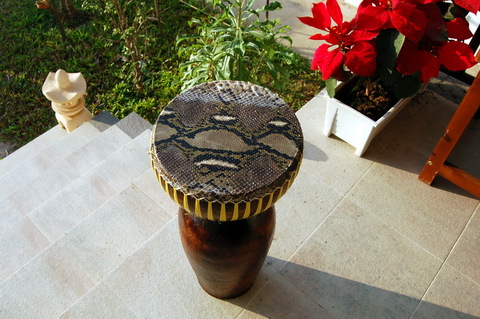
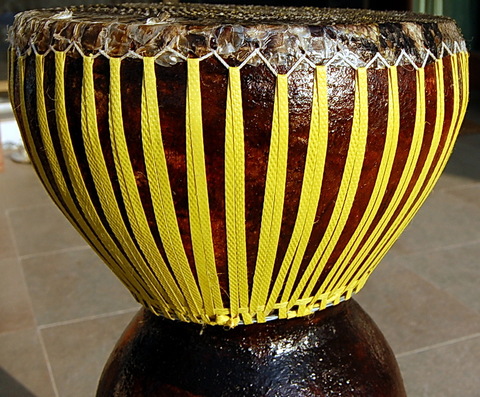
On the way to my uni’s sports day a couple weeks ago, we stopped off at a famous temple (from the ancient “kao noi ka mae” story) where they sold various trinkets, sticky rice baskets, and musical instruments at a series of stalls on the dusty temple grounds.
After testing out this drum and hearing how nice it sounded, my coworker and I debated about who should buy it. He said he had too many drums already, so I bought it. The man who sold it to me didn’t say who made the drum, who killed the snake, or if it tasted delicious, and I didn’t ask. Just having a drum with a snakeskin head is cool enough. One thing was kinda gross, though. The first day of pounding on it, scales were flying off everywhere. I looked down once to find my forearm covered in snake scales that were sticking to my sweaty skin. It was djembeistic and cathartic as hell.
Basic Specs
- 100% Natural Boa Constrictor Head, 9″ (~23 cm)
- Glazed pottery body
- Expertly tied with 100% natural cotton twine and 100% artificial plastic straps
- Deep throbbing bass response
I will cry out loud when this thing eventually breaks, it’s way too cool.
Wan Macha Fish Sanctuary
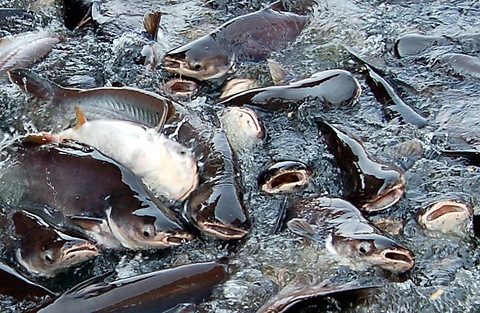
We visited what’s possibly the greatest tourist attraction in Mahasarakham again (well, besides the new Big C, of course).
I Saw the Queen of Morlum (and Molam and Mawlum and Morlam)
Her name is Banyen Rakgan, and here I must quote Wikipedia:
“Banyen was the first national mor lam star, whose appearances on television in the 1980s brought the form to an audience beyond its northeastern heartland. She bridges the gap between traditional and modern mor lam, normally appearing in traditional clothing, but using electrified instruments and singing luk thung and dance influenced songs.”
The basic story of how I found myself ten feet away from Banyen performing live is simple: It was serendipitous.
////////////////////
I work at Rajabhat Mahasarakham University. There are many Rajabhat universities located all over Thailand. A few days ago I went to the Rajabhat in Ubon Ratchathani (where the US Air Force created a base during the Vietnam War) with 450 other teachers from my university for what they call a “sports day,” and insofar as helping my tug-of-war team lose twice and thus tie for third place (the victories needed for such were achieved before I came in at the semifinals), I guess I did play sports. Sports Day this year was actually two days – we arrived on February 4th for the opening ceremony and dinner, and played sports on the 5th with teams fielded by all the other Rajabhats in the Isan (NE) region.
According to a close friend, Banyen has been overseas (mostly in the states) for some years and only recently returned to Thailand. She’s a teacher at the music department at the very university we were visiting, which explains why she was performing at the closing ceremony/dinner. She is now 55 years old and has only become more beautiful with age. Everyone calls her “Ajarn Mae” which are respectively the words for teacher and mother in the Thai language. This encompasses the feelings that most Thais, and especially most Thais from Issan have for her – they grew up on her music and she is a national hero; she is also the most famous molam singer in the world. This much I have studied since the last time I really wrote about molam on this blog. Incidentally, Banyen is also a student of Ajarn Chawiwan Damnoen (who I guess would have to be called the Queen’s mother), who sang at our wedding in 2006 and is also a living treasure…
I had no idea what was going on when Banyen started singing, as we were working through the free food and booze at my table in an auditorium crammed with several hundred university employees. However. I was drawn to her voice, and soon found myself threading through a crazed yelling mass of fellow teachers who were temporarily achieving enlightenment with an instinctive dance passed down through their DNA. I eventually reached the center stage and there was only a single row of people in front of me. People were offering her money as they do here – from grade school performances all the way to stadium concerts – and when she came to accept it, I saw that her dress was made from what looked like polished pieces of broken mirror… There is no way to describe the sound. It flowed through my body and I felt it as much as heard it. The primeval beat of the drums, the fluctuating melodies of the Kaen reed flute, and the luscious voice of Thailand’s Queen of Molam (I use that word because this type of Molam is basically flirting)… For a few minutes I was lost in the groove, which is something I haven’t felt for a long, long time. Dare I say it? Yes. For a few minutes, I too achieved an enlightened state. A state that I hereby coin as Molamgasm.
//////////////
The video I took on my crappy old cellphone is so bad, I was determined not to bother posting it here. The more I thought about it, though, the more I became convinced that it would be an interesting experiment: Perhaps Banyen’s presence transcends the absolutely horrible quality of the video. Possibly not. Oh well, it’s all I’ve got:
What a shame. I’m pretty sure this was a once in a lifetime opportunity. Then again, it probably plays better in my memory than it ever would on YouTube. Speaking of which, if you want to see much better videos of Banyen, she is well represented there. Here are two of my favorites: LINK 1, LINK 2
If I ever have a chance to see Banyen that close again, I’ll be sure to have a decent camera. Or maybe I’ll just ask Ajarn Chawiwan to introduce me…
New Years in the Fields
As promised, here’s the whole story:
On the second day of the new year, our nanny invited us to her village for the bi-annual emptying of a communal fishpond. We piled into our trusty ’71 Crown, picked up a Japanese teacher who wanted to experience village life, and headed out deep into the rice fields. Actually, we first stopped at our nanny’s village so we could follow a pickup out to the final destination. I always carry rubber mats, wooden planks, and a shovel in the back of my car to get out of mudholes and sandy spots encountered in the back country, but with the family along for the ride it was comforting to have an escort (also, you never know when a feral Brahmin cow will decide to play cape buffalo and it’s nice to have a pickup to play decoy in such situations). The road was non-existent in places and we simply drove over drained and harvested rice fields along the paths of least resistance; I only scraped bottom once when I misjudged the far side of a steep bump. Several times, the pickup driver stopped an got out to warn me about a particularly rough patch ahead and asked if I just wanted to stop and park, but choosing the right lines is something of an obsession when I’m driving and I was lucky enough to choose correctly that day.
We eventually arrived to within walking distance (perhaps half a kilo) of the pond, which was being drained with a pump attachment hooked up to an iron buffalo (large roto-tiller or walking tractor). While waiting for the pond to drain, most of the hunters were out looking for field rats. This is where I started photo documenting the day.
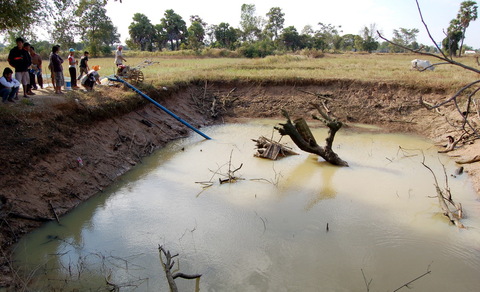
////////////////// EXTREME GNARLINESS WARNING!! ////////////////////
IF YOU HAD A HARD TIME READING THE LAST POST ON EATING RATS, GO NO FURTHER. GRAPHIC RAT BUTCHERING FOLLOWS (YUM).
The method employed for catching rice field rats on this day was simple and effective. Rats make their tunnels in berms that separate rice fields. A fire is built at the entrance of a rat hole and inside the tunnels, the rats only dig deeper to escape the smoke. Some time after, the tunnels are dug out, and the asphyxiated rats are pulled out by hand.
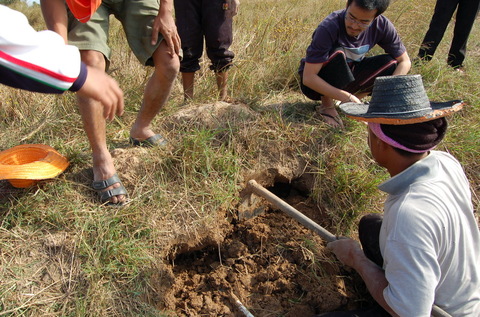
(As it turned out, most of my photos that day were of preparing the rats for eating. The actual reason why we went, draining the fishpond, I mostly recorded with a camcorder. Some of the footage is pretty interesting but I don’t have time to process it yet.)
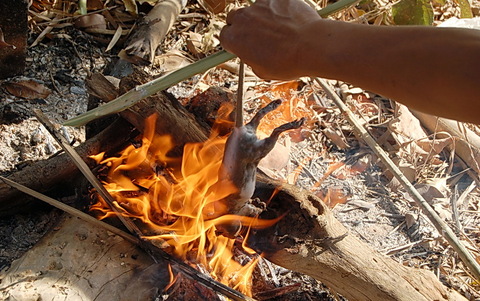
All in all, it was an extremely educational day. It’s always nice to be able to hang out with the locals and see how they really live. It’s even nicer when they are willing to show you exactly how they do what they do. On this day, we learned how to empty a fish pond, catch and cook rats, and as a bonus, I learned just how rough a road the old Crown can handle.


